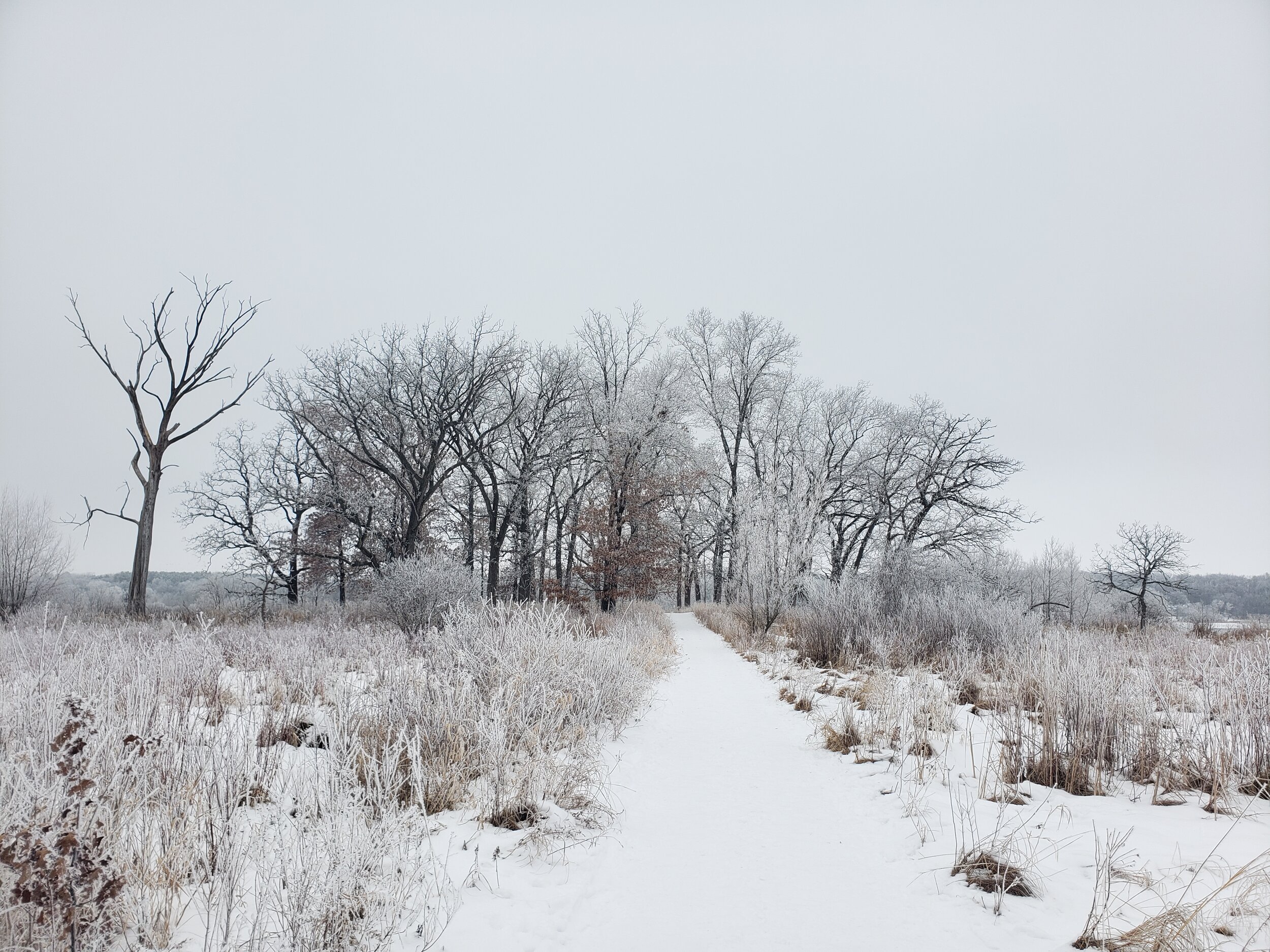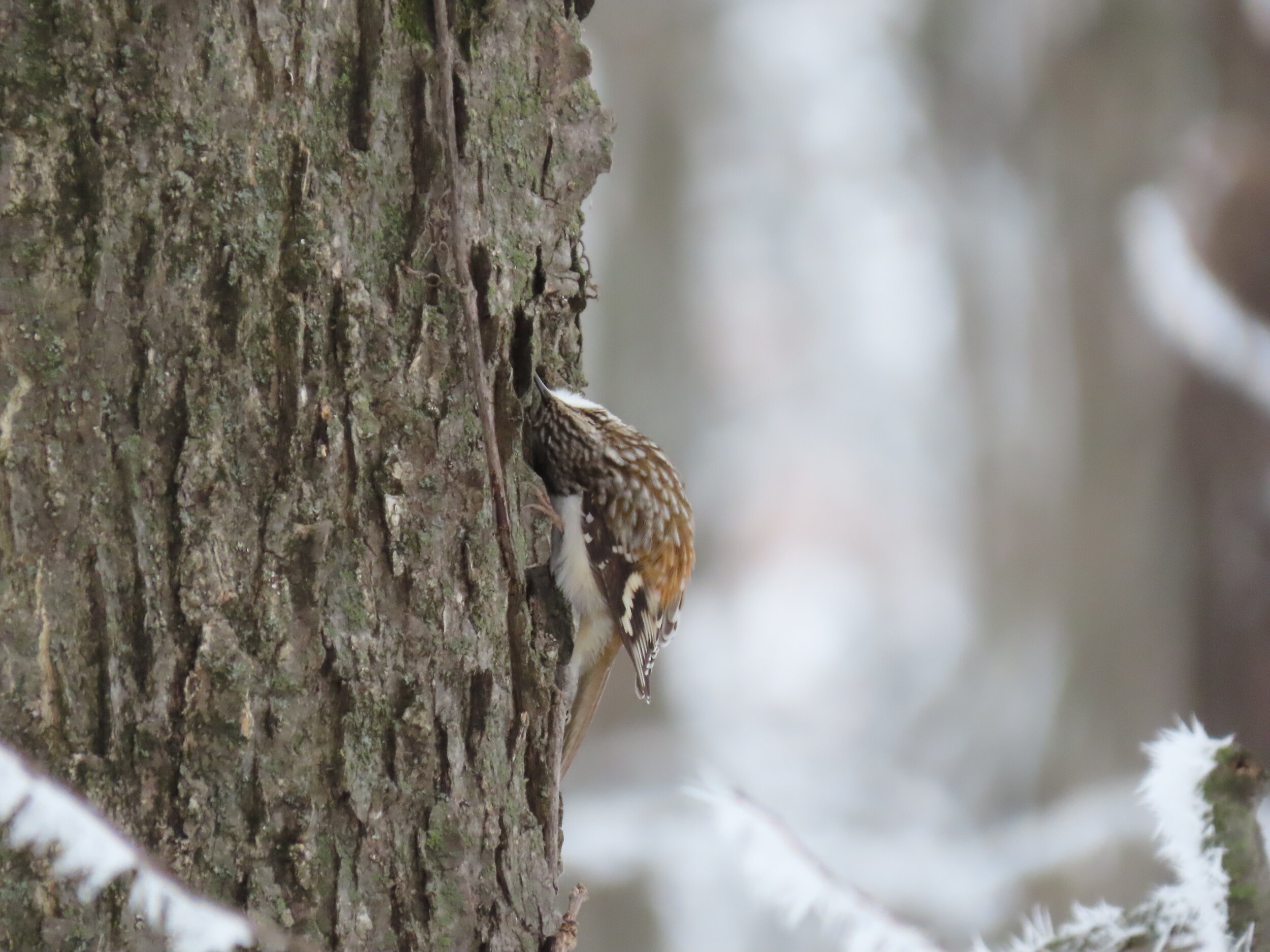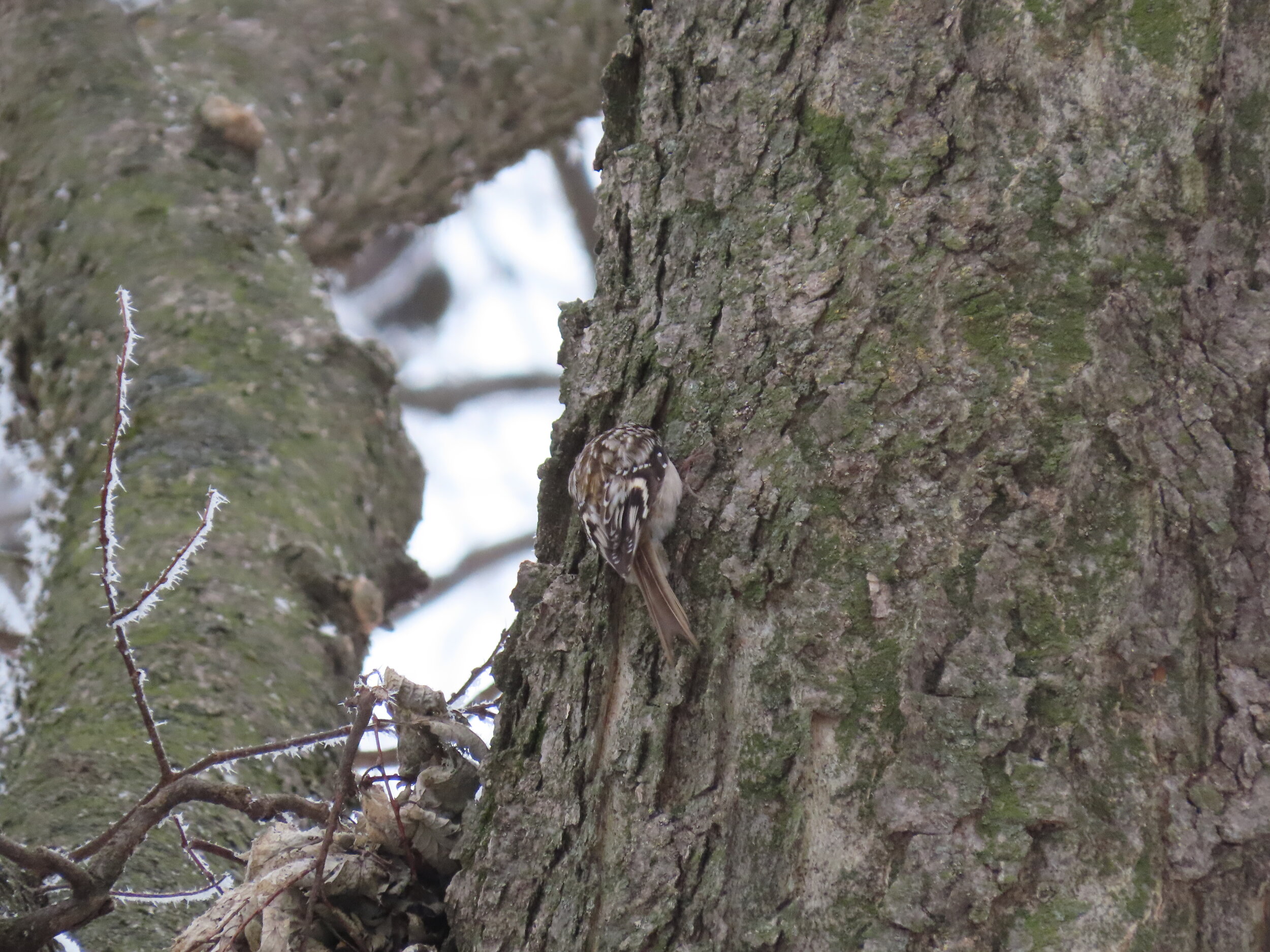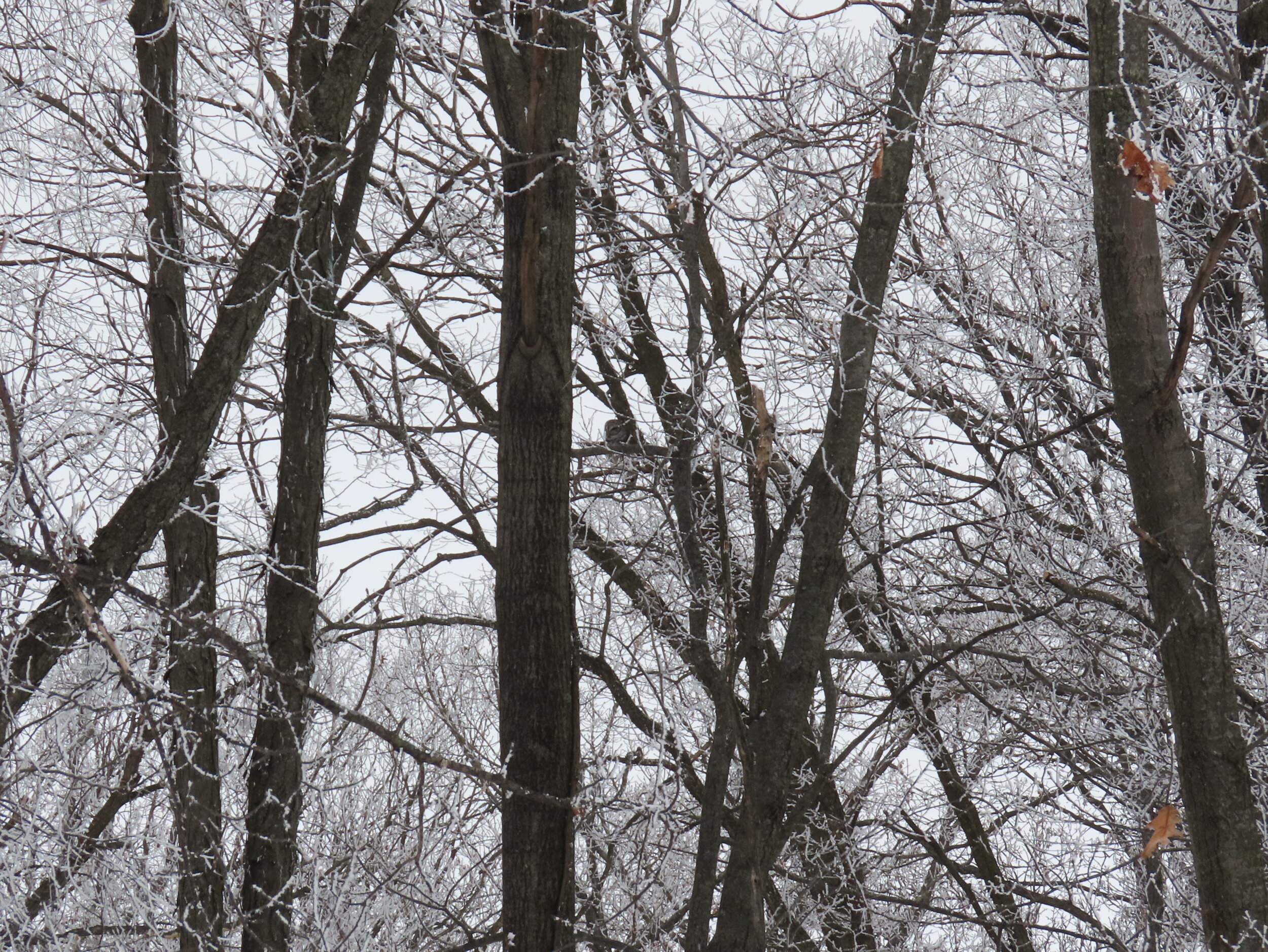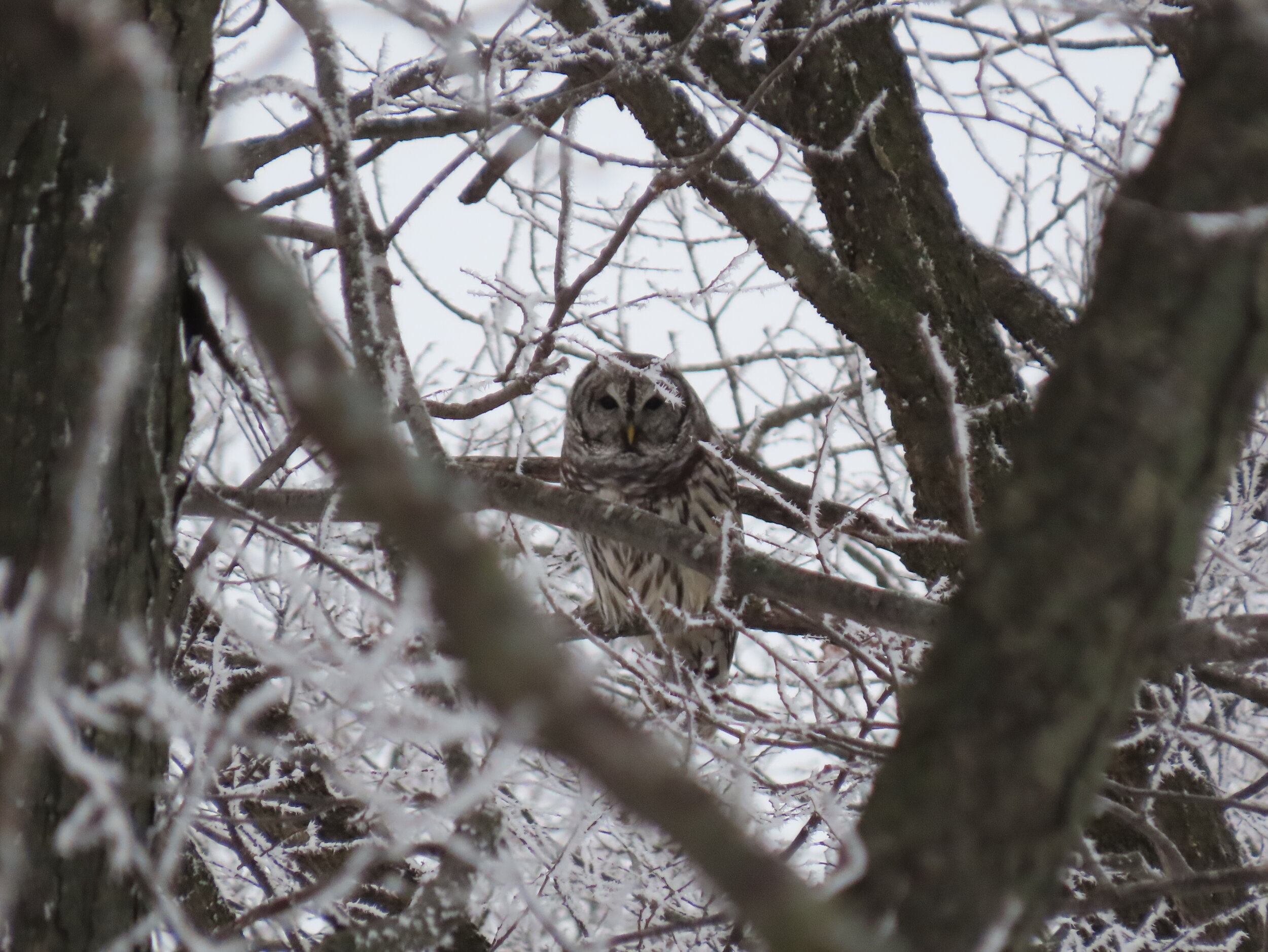Do you remember back in May when we went on a virtual field trip to the north unit of Cherokee Marsh? The marsh and woods were warm and green, warblers and flycatchers were picking bugs from the trees, sedge wrens were popping up from dense thickets to scold us as we went by, and virginia rails were grunting along the marsh boardwalk's edge.
It's January now and the marsh has a different look, a different tune—perhaps a quieter, softer one, but one full of just as much life. This week's Entryway to Birding blog takes us back to Cherokee North with another birding field trip to see how things have changed with the seasons. Read on for tips on what birds you might expect to find at different locations throughout the marsh in winter.
The morning’s heavy fog had left the marsh coated in rime ice (or is it hoar frost? I have been unable to keep the two straight!). Either way, it was a calm, frosted morning for birding. Photo by Caitlyn Schuchhardt
Winter Birding Realities
This winter edition will be a text-only field trip. As much as I'd love to do a filmed, virtual walkthrough like last time, the cold weather is cramping my style—literally. My phone battery will plummet if my phone is out in the open too long and my filming hand gets cold! (If anyone has suggestions for how to manage those winter-filming challenges, I'd love to hear them—leave a comment below!)
Winter birding has plenty to offer, even if the bird activity is low. Photo by Caitlyn Schuchhardt
But even though my filming attempt didn't work out, I wanted to post this write-up of my walk because I think it is important for new birders—especially new birders birding through their first winter—to see what an average birding outing in winter looks like. It's easy to succumb to this feeling that "Oh, I should be seeing more! I saw someone else saw this species, why can't I find it? Where the heck is everything?!" and to feel like your outing wasn't good enough because it didn't meet your expectations of what you thought it would be.
Maybe you don't think like that. But maybe you do. Maybe you can relate to setting those unrealistic expectations and being too hard on yourself when they don't come true—because I sure know that I did that a lot to myself as a new birder.
It's a tough habit to break, so here is my open and honest bird walk through Cherokee North, full of all the things I saw and all of the things I wanted to find but didn't. I would say this is a typical winter outing for me—a mostly quiet walk with a few pockets of activity that were worth slowing down and standing in the cold for, plus one big highlight.
My Route
I followed mostly the same route that I took in our May walk, but I did truncate it a bit because I was getting cold and tired near the end. I made a quick map below by tracing over my “tracks” from my eBird checklist—each color marks a different area/habitat I'll talk about and the numbers mark the order I walked them in. Don’t be limited by this on your visit—you can explore the park however you’d like (there’s more of it not even on this map!!).
(Note: If you use eBird, you should know that your tracks are always private—only you can see your route! Others will only see the time and distance you traveled.)
This is a shortened version of a route I travel often, but it’s not everything there is at Cherokee North! There’s more of the park to the south, so be sure to explore those trails too! This route will give you a variety of habitat—each color marks a different section I’ll reference in the walkthrough below.
Note: During my visit, the trails were snow-covered but the snow was not packed so much that it was slippery or icy yet. I did wear my ice cleats just as a precaution but I would have felt fine without them. It’s always smart to plan ahead and be prepared with appropriate footwear choices!
Stop #1: The Edge of the Woods
I'll be the first to admit, I'm a creature of habit when it comes to Cherokee North. I always take the small, side-trail that leaves from the left side of the parking lot (if you are facing the restrooms). The trail is set back a little and it's easy to miss if you aren't looking for it. It cuts along the back edge of the woods before curving down to connect with the wide, gravel path that runs straight between the woods and the marsh.
As I walk along the back edge of the woods, I am carefully scanning the branches of the bare deciduous trees for any strange lumps that may be an owl. I'm listening for quiet chips or rustles in the brush along the path for winter sparrows, like dark-eyed juncos or American tree sparrows, who might be enjoying the prominent "edge habitat" along here, where the nearby prairie meets the woods' edge.
I love this path! This is where my Cherokee North walks usually begin—it is the view you’ll see as you walk the back edge of the woods, walking away from the parking lot. Sometimes it’s incredibly birdy. Today it was not. Photo by Caitlyn Schuchhardt
What birds did I find along this first stretch? None. I didn't add a single bird to my list as I walked this back path. This surprised me only a little—I was thinking I'd at least hear a distant woodpecker or nuthatch, but sometimes things are just that. Quiet.
This path curves along the back edge of the woods and reaches an intersection where you might take a left and continue walking between prairie and woods, or you might continue straight down a slight decline, where you'll approach the main gravel path that will give you a view of the Yahara. I went straight and headed towards the Yahara, and this next intersection is where I had my first flurry of activity. The chickadees were here!
Had this been a downy woodpecker, the branch that obscures the woodpecker’s bill would have pretty much hidden the downy’s shorter bill. The longer bill on this bird (which the branch thankfully emphasized!) helped me instantly ID this as a hairy woodpecker. Photo by Caitlyn Schuchhardt
Whenever I find chickadees in winter, I'll slow down and pay close attention to my surroundings. I almost always find other birds nearby, and this time was no different. A hairy woodpecker gave a sharp, loud chip before it flew to a frost-covered branch and began hammering away. I heard a fainter, more delicate drumming nearby too and was able to spot a downy woodpecker on a thin branch (small enough that I'm tempted to call it a twig—typical downy behavior!).
Winter birds I would expect to find in this area: downy woodpecker, hairy woodpecker, red-bellied woodpecker, pileated woodpecker (on a lucky day), dark-eyed junco, northern cardinal, black-capped chickadee, brown creeper, white-breasted nuthatch, red-breasted nuthatch, great horned owl (on a lucky day)
Stop #2: The Yahara River
Once you've reached this main gravel path, you'll notice a change in habitat. The woods open up here and the Yahara stretches into view. Here is more prime "edge habitat" as you make your way to the path that leads to the water. Sounds of waterfowl tell me there is open water on the Yahara yet, and I can spot some of it from here.
As I walk down to the water, my eyes will turn upward, scanning for anything soaring above. I look for red-tailed hawks, or perhaps a bald eagle that may be hunting the open water. I’ll make a point to scan the treelines around me and across the river for any perched raptor. Looking north, there are lots of distant trees that lean out over the water and I know that the resident bald eagles love to perch on them if they are around.
The view from the snow-covered metal boardwalk that runs along the Yahara’s edge. Ducks, geese, and a few flyover tundra swans were the highlight here. Photo by Caitlyn Schuchhardt
But alas, I saw no raptors of any kind. I was greeted by lots of mallards as I reached the water and metal boardwalk that skirts its edge, though. I always approach this area slowly and quietly, as the ducks can be very skittish and I don't want them to move too far away. But no matter how quiet I think I am, they will always swim away from the shore—and I do enjoy seeing them drift away en masse as they cast me sideways glances.
There was more open water here than I was expecting to find, so I took some time to carefully scan and see if I could spot anything that wasn't a mallard. And sure enough—I found two gadwall (identified by their characteristic black butt and white wing patch) and two northern shovelers (identified by their wide, hefty bill). Many of the ducks were far away and distant silhouettes—I eBirded them under "duck sp." because I couldn't tell which species they were, but I wanted to make sure their presence was accounted for.
On my walk back, I heard the nasal yanks of a white-breasted nuthatch in the oaks near the metal boardwalk—my first of the trip. I looked carefully along in the reedy, brushy areas along the path for a winter wren (a small, very dark wren with a short tail) but had no luck. I retraced my steps back to the woods and the wide gravel path.
Winter birds I would expect to find in this area: mallard, gadwall, northern shoveler, tundra swan, common merganser, hooded merganser, red-tailed hawk, bald eagle, white-breasted nuthatch, downy woodpecker, hairy woodpecker, red-bellied woodpecker, black-capped chickadee, American tree sparrow, winter wren (on a lucky day)
Stop #3: In The Woods
Once you return to the wide gravel path, take a left and head north along the path. I follow this flat, level path as it cuts through the woods and curves around the base of the hill on the north side of the park, before I eventually take the trail that cuts over the hill.
As I'm walking this section, I am looking and listening for more woodpeckers and nuthatches, but also the delicate trill of a brown creeper that may be spiraling up the bark of the trees. Brown creepers are one of my favorite birds to look for in winter and I've worked hard to finely tune my ear for their calls. (Click on the second call listed here for an example of what you may hear in winter.)
I've thought a lot about how to describe the noise they make that will literally stop me in my tracks, and I've realized that (to me) the trill they make sounds like a faint, delicate referee whistle. If I hear some high-pitched chips punctuated with that soft referee whistle, I stop—as if I am in a game and the brown creeper has called for pause.
Then it is a challenge to spot them—and this is where patience comes in handy. Look for the slightest movement along the edges of the bark, where you might catch their silhouette as they spiral up around the corner of a trunk. Look for a flash of creamy white on their belly, which you may only catch from the side. Good luck spotting them dead-on—their plumage is a perfect match for bark.
I found a lot of brown creepers during my visit—two along this stretch and four more throughout wooded areas along the rest of my walk. They were being gracious and easy-to-spot on this day and allowed me the chance to study their movement patterns and how they use their stiff tails to help maneuver their way up the tree.
Winter birds I would expect to find this area: red-bellied woodpecker, hairy woodpecker, downy woodpecker, pileated woodpecker (on a lucky day), black-capped chickadee, brown creeper, white-breasted nuthatch, northern cardinal, blue jay, great horned owl (on a lucky day)
Stop #4: Over the Hill
Before you reach the path that goes over the hill, you’ll walk by this platform—another great spot to view the Yahara! Photo by Caitlyn Schuchhardt
The wide gravel path will reach an intersection where you can go left to continue through the woods, or right to head out onto the prairie. Go right if you’d like to bypass the steeper trail over the hill, otherwise go left and continue until you see a small path that leads up the hill. (If you opt to go through the prairie instead, you can walk a flatter route to reach the pond, our next stop.)
My slow meander up the hill was filled with more woodpeckers—downy and red-bellied—and two more brown creepers. But the surprise find was not one, but two northern flickers! I tried really hard to get a picture of them, but they only wanted to be seen from afar—they would fly further away anytime I moved forward. I don't always expect to see northern flickers in the winter, but there certainly are some around. I noticed their white rumps as they flew away from me and could catch the flash of yellow on the shaft of their wing feathers that helped me confirm they were indeed flickers.
I reached the crest of the hill—which has one of those perfectly placed benches—and enjoyed the view below before I made the trek down the hill towards the pond.
It’s hard to not enjoy this spot. Coming out of the woods and experiencing the view at the overlook is always one of my favorite Cherokee Marsh moments—every single visit. Photo by Caitlyn Schuchhardt
Winter birds I would expect to find in this area: downy woodpecker, hairy woodpecker, red-bellied woodpecker, pileated woodpecker (on a lucky day), northern flicker, brown creeper, black-capped chickadee, white-breasted nuthatch, great horned owl (on a lucky day)
Stop #5: The Pond
As I made my way down the hill towards the pond, things seemed quiet but I still kept an eye out for any movement in the woods to my left. And then. There. Something slightly ... off ... in the tree branches caught my attention. I stopped in my tracks, but I couldn't spot anything. I took three steps back and looked again.
There. That wide, weird branch didn't seem right. As I raised my binoculars, the branch transformed into a beautiful barred owl. This was the first barred owl that I've seen at Cherokee North, ever. I know others report finding them there, but I myself had never spotted one. Great horned owls, yes, but barred, no. They had evaded me. I felt very lucky on this day.
The habitat was perfect, with the pond just around the bend. Barred owls enjoy areas where there are some woods with marshy habitat nearby. It made me think that I should pay more attention and scan further back in the trees on future visits—this owl was tucked far back and I wouldn't be surprised if I had missed it entirely.
As for the pond itself (now of course frozen over and covered in snow), I had nothing, nothing! I did not record any birds in this area—no flyover raptors, no sparrows in the brush, no woodpeckers, nothing. It was quiet here, but I didn't mind. I was still riding the high from that barred owl sighting—the highlight of my day.
Winter birds I would expect to find in this area: downy woodpecker, hairy woodpecker, red-bellied woodpecker, pileated woodpecker (on a lucky day), dark-eyed juncos, black-capped chickadee, American tree sparrow, swamp sparrow, winter wren, red-tailed hawk, and apparently barred owl (on a very lucky day)
Stop #6: The Wide Open Marsh
From the pond, turn left and continue following the trail. The trees will be left behind for a stretch and the marsh will open up into a wide expanse. Here is where I had my first and only American tree sparrow of the day—a close flyover that allowed me to see the single spot on it's chest before it landed in the tall grasses.
The trail moves along the edge of the woods before it curves towards more prairie and marsh. You’ll pass a fenced off area at the base of the hill; I noticed some rustling noises at this spot. I watched for a moment and was treated to a sweet surprise—a curious, watchful opossum who eventually poked his pink snout out from behind a log. This isn't the first opossum I've seen at Cherokee North—I oddly enough always spot them in winter—but my sightings of them are infrequent, so I was pleased to be able to get a photo of this little critter as he poked among the snow.
A curious opossum explores the area near a fallen, decayed log. Photo by Caitlyn Schuchhardt
I saw movements in the trees along the edge of the field and was able to spot both those northern flickers again, in the same tree. In their earlier fashion, they proceeded to fly further away from me.
As I continued along the path—now flat and level again as it cuts across the marsh—I started to feel the chill of the day set in. I was in an open area and the wind had picked up, so I decided to make my way back to the parking lot. I walked as far as the beginning of the metal boardwalk, then turned right to head back to the road and parking area.
I didn't see any birds along this final stretch, though I had my eyes and ears out for signs of some overwintering eastern bluebirds, which I had seen someone else report in the area. While many migrate, don't be surprised to find a couple that choose to stay.
Winter birds I would expect to find along this stretch: American tree sparrow, black-capped chickadee, dark-eyed junco, northern cardinal, blue jay, red-tailed hawk, maybe an overwintering eastern bluebird
Two hours later …
2.49 miles and 110 minutes later, I was back at my car. I checked the parking lot for birds (always check the parking lot, birds love parking lots because of that good ol' edge habitat!) but it was still just as quiet as when I began.
I ended with 15 species on my walk—click here for my eBird checklist—with two notable finds (those northern flickers and that stunning barred owl) and several notable misses (red-tailed hawk, American crow, northern cardinal, blue jay, and dark-eyed junco, surprisingly.)
I started my walk thinking it was going to be a quiet and not-very-birdy walk, since activity seemed low. That is how I feel on pretty much all my winter outings, but by the end I'm usually feeling differently. In winter, bird activity can feel scarce but that makes each sighting somehow feel a little more special.
Even if I had only seen one or two birds, the rime ice was spectacular enough to make this visit a memorable one. Photo by Caitlyn Schuchhardt
Most of the birds that I added to my list were found in areas where I noticed small pockets of activity—these are spots I would stand and wait and listen. More often than not, something else would catch my attention. Don't be afraid to wait, but also don't be afraid to move on if it's proving truly quiet. Sometimes winter birding is quiet, and those are the moments where I stop to admire the rime ice, the animal tracks, and the winter wonders around me.
I hope my walk through Cherokee North helps guide your own visit. Maybe you'll see some of what I did. Maybe more! Maybe less. Go in with your expectations suspended and every sighting will be a thrill.
Happy birding! I'll see you next week. In the meantime, let me know what you're finding at Cherokee North in the comments below.
_____
Caitlyn is the Communications and Outreach Assistant at Madison Audubon. She’s crazy for birds because they changed her life. She’ll be back next Monday with some tips and tools for birders, new and experienced! Between now and then, she’d love to hear about the birds you’re seeing and hearing. Leave a comment below or email to drop her a line!


